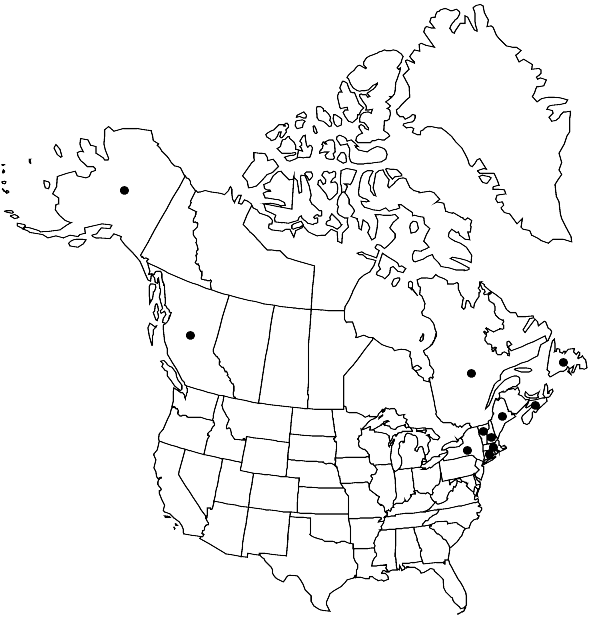Difference between revisions of "Sphagnum andersonianum"
Bryologist 83: 60, figs. 1–7. 1980,.
FNA>Volume Importer |
FNA>Volume Importer |
||
| Line 21: | Line 21: | ||
|elevation=low to moderate elevations | |elevation=low to moderate elevations | ||
|distribution=B.C.;Nfld. and Labr. (Nfld.);N.S.;Que.;Alaska;Conn.;Maine;Mass.;N.H.;N.Y.;R.I.;Vt.;Europe. | |distribution=B.C.;Nfld. and Labr. (Nfld.);N.S.;Que.;Alaska;Conn.;Maine;Mass.;N.H.;N.Y.;R.I.;Vt.;Europe. | ||
| − | |discussion=<p>Sporophytes are uncommon in Sphagnum andersonianum. Its distribution is uncertain due to past taxonomic confusion with S. rubellum, S. capillifolium, and other closely related species in sect. Acutifolia. This is one of the most hydrophytic species of the section and is often associated with S. angustifolium, S. fallax, and S. rubellum. It is often not easily distinguished from S. rubellum, with which it may intergrade in a manner similar to that already demonstrated for S. rubellum and S. capillifolium by N. Cronberg (1997, 1998). Phenotypically S. andersonianum is a softer, paler plant with branch leaves that are more ovate and concave on branches that are less 5-ranked. Sphagnum rubellum also has the branch leaves sometimes subsecund while in S. andersonianum they are straight. Ecologically S. rubellum is an open mire species of usually ombrotrophic conditions, where it often forms hummocks, while S. andersonianum occurs in more sheltered sites where there is some mineral influence. Where they occur together, S. rubellum is on the tops of hummocks and S. andersonianum is on the hummock sides and bases. Microscopically S. rubellum has stem leaves with at least some of the hyaline cells twice septate, while in S. andersonianum none are twice septate.</p> | + | |discussion=<p>Sporophytes are uncommon in <i>Sphagnum andersonianum</i>. Its distribution is uncertain due to past taxonomic confusion with <i>S. rubellum</i>, <i>S. capillifolium</i>, and other closely related species in sect. Acutifolia. This is one of the most hydrophytic species of the section and is often associated with <i>S. angustifolium</i>, <i>S. fallax</i>, and <i>S. rubellum</i>. It is often not easily distinguished from <i>S. rubellum</i>, with which it may intergrade in a manner similar to that already demonstrated for <i>S. rubellum</i> and <i>S. capillifolium</i> by N. Cronberg (1997, 1998). Phenotypically <i>S. andersonianum</i> is a softer, paler plant with branch leaves that are more ovate and concave on branches that are less 5-ranked. <i>Sphagnum rubellum</i> also has the branch leaves sometimes subsecund while in <i>S. andersonianum</i> they are straight. Ecologically <i>S. rubellum</i> is an open mire species of usually ombrotrophic conditions, where it often forms hummocks, while <i>S. andersonianum</i> occurs in more sheltered sites where there is some mineral influence. Where they occur together, <i>S. rubellum</i> is on the tops of hummocks and <i>S. andersonianum</i> is on the hummock sides and bases. Microscopically <i>S. rubellum</i> has stem leaves with at least some of the hyaline cells twice septate, while in <i>S. andersonianum</i> none are twice septate.</p> |
|tables= | |tables= | ||
|references= | |references= | ||
| Line 44: | Line 44: | ||
|publication year= | |publication year= | ||
|special status= | |special status= | ||
| − | |source xml=https://jpend@bitbucket.org/aafc-mbb/fna-data-curation.git/src/ | + | |source xml=https://jpend@bitbucket.org/aafc-mbb/fna-data-curation.git/src/8f726806613d60c220dc4493de13607dd3150896/coarse_grained_fna_xml/V27/V27_82.xml |
|genus=Sphagnum | |genus=Sphagnum | ||
|section=Sphagnum sect. Acutifolia | |section=Sphagnum sect. Acutifolia | ||
Revision as of 16:57, 18 September 2019
Plants small, soft and slender; capitulum small; pale pink to pale purplish red; without metallic lustre when dry. Stems pale brown, green or red, rarely purplish red; superficial cortical cells aporose. Stem leaves lingulate, 0.9–1.2(–1.4) mm, apex rounded-erose to sometimes slightly apiculate, border moderately strong and broadened at the base (to 0.8 the width); hyaline cells rhombic, 0–1-septate, usually efibrillose. Branches not or slightly 5-ranked, lax. Branch fascicles with 2 spreading and 1–2 pendent branches. Branch leaves ovate, 0.8–1.4 mm, distinctly concave, straight, apex dentate and involute; border entire; hyaline cells on convex surface with elliptic pores along the commissures, grading from smaller pores near the apex to larger pores at the base, concave surface with large round pores on the proximal portions of the leaf. Sexual condition dioicous. Spores 18–24 µm; coarsely papillose on both surfaces; proximal laesura less than 0.5 the length of the spore radius.
Habitat: Weakly minerotrophic
Elevation: low to moderate elevations
Distribution

B.C., Nfld. and Labr. (Nfld.), N.S., Que., Alaska, Conn., Maine, Mass., N.H., N.Y., R.I., Vt., Europe.
Discussion
Sporophytes are uncommon in Sphagnum andersonianum. Its distribution is uncertain due to past taxonomic confusion with S. rubellum, S. capillifolium, and other closely related species in sect. Acutifolia. This is one of the most hydrophytic species of the section and is often associated with S. angustifolium, S. fallax, and S. rubellum. It is often not easily distinguished from S. rubellum, with which it may intergrade in a manner similar to that already demonstrated for S. rubellum and S. capillifolium by N. Cronberg (1997, 1998). Phenotypically S. andersonianum is a softer, paler plant with branch leaves that are more ovate and concave on branches that are less 5-ranked. Sphagnum rubellum also has the branch leaves sometimes subsecund while in S. andersonianum they are straight. Ecologically S. rubellum is an open mire species of usually ombrotrophic conditions, where it often forms hummocks, while S. andersonianum occurs in more sheltered sites where there is some mineral influence. Where they occur together, S. rubellum is on the tops of hummocks and S. andersonianum is on the hummock sides and bases. Microscopically S. rubellum has stem leaves with at least some of the hyaline cells twice septate, while in S. andersonianum none are twice septate.
Selected References
None.